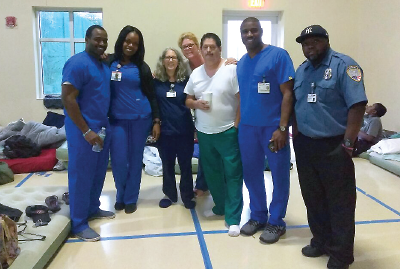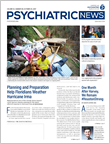For the four days before Hurricane Irma made landfall on mainland Florida on September 10, it was all hands on deck for physicians and staff at BayCare Health System and BayCare Behavioral Health.
As Irma approached the coastal tip of the state, contingency plans had to be made for all Baycare facilities, taking into account the possible paths of the storm. (BayCare’s headquarters are in Clearwater, but it has facilities throughout Tampa Bay and Central Florida.) Supplies of water, medications, and fuel had to be secured.
Eventually, four behavioral health facilities within the BayCare Health System were evacuated, including a residential facility for traumatized children and adolescents and a residential facility for patients with substance use disorders. In hospitals that remained open, physicians and nursing staff brought sleeping bags and “camped out” for the duration.
Psychiatrist Nick Dewan, M.D., chief medical officer at BayCare Behavioral Health, recalled the period of planning and preparation as tense, anxious, and uncertain, but also steady and focused.
“As an organization, we had to plan for and adjust to any number of possible scenarios,” he told Psychiatric News. “We didn’t know if the storm would travel up the eastern coast or ride up the Gulf coast on the west and hit Tampa directly. We had to determine which of our facilities would be in flood zones and which would not. We had regular conference calls with senior management, as well as meetings within our own division with physicians and staff.”
The preparations at BayCare mirrored those by psychiatrists and other physicians at hospitals and health care facilities throughout Florida, as the Category 5 storm churned across the Caribbean and headed for the Florida Keys.
BayCare’s medical facility—Morton Plant North Bay Hospital, in New Port Richey, Fla.—was evacuated, along with four BayCare behavioral health facilities: Morton Plant North Bay Hospital Recovery Center (a 72-bed facility in Lutz), the BayCare Behavioral Health–Statewide Inpatient Psychiatric Program (SIPP) for Children, in New Port Richey, and the Community Recovery Center and Integrated Stabilization Unit, both of which are also in New Port Richey.
Patients at all facilities either returned home to their families or were transferred to other BayCare facilities in various parts of the state. Children at the SIPP facility who could not go home were transferred to St. Joseph’s in Tampa. The entire behavioral health staff accompanied the children to St. Joseph’s—where there were also 75 family members “camping out” with their loved ones, as well as some 37 pets in crates (sheltered in sealed sections of the hospital).
“All of this transportation was done in hospital vans the day before the Hurricane made landfall since we knew we couldn’t be driving around in hurricane-force winds,” Dewan said.
By Friday, September 8, hundreds of thousands of Floridians had evacuated for points north in what was described as the largest mass evacuation in U.S. history. When Irma’s eye passed over Naples, Fort Myers, and Tampa on September 10 and 11, it had lost some strength but remained a fierce and potentially deadly storm.
BayCare physicians and staff were battened down. “For three and a half days you are hypervigilant, and then the thing is on you,” Dewan said. “I remember looking out at the pelting rain and seeing a light pole in the parking lot shaking violently in 80-mile-per-hour winds.”
When it was over, power outages were nearly universal across the state, and it was days before the extent of storm damage could be determined. Some 70 deaths were attributed to the storm, and there was substantial destruction of homes and other property in the hardest hit areas, especially in the Florida Keys.
But given the magnitude of Irma, it became clear as thousands of Floridians returned to their homes that the state had emerged battered but not devastated. This is Florida, after all, no stranger to hurricanes, and Dewan and others with the Florida Psychiatric Society (FPS) credit three things: planning, planning, and planning.
FPS President Rajiv Tandon, M.D., said the district branch, headquartered in Tallahassee, offered help to the governor’s office, which has been coordinating all hurricane-related operations, and to physicians around the state. “The good news is that our services have not been called upon,” he told Psychiatric News. “We think this is because the evacuation was massive, early, and relatively orderly, or at least not chaotic.”
Margo Adams, executive director of the FPS, agreed. “We plan continually and implemented well,” she told Psychiatric News. “It wasn’t comfortable or convenient or flawless, but no state handles water storms better than Florida.
“There was pretty widespread flooding in South Florida, and some in Northeast Florida, but it was more tidal than Houston’s rain and rivers, so the waters receded in days rather than weeks,” Adams said.
Communicating with Psychiatric News in the last days of September, Adams said, “We won’t hear for a while about the inland agricultural counties where food and supplies were being flown in from here. There are still housing issues in the Keys, but FEMA is working on them.
“We were hit pretty thoroughly, but looking now at Puerto Rico in the aftermath of Maria, and looking at the damage Irma did in the islands and Harvey [in Texas], I feel fortunate as a Floridian for our planning and our resourceful and caring citizens,” Adams said. “We have had members contribute to recovery efforts in Texas and Louisiana, and now our folks are looking at what we can do for our neighbors in the islands. And not all of our members have completely finished with their own recovery efforts.
“Psychiatrists are good people,” Adams said. ■
The website of the FPS can be accessed
here.


